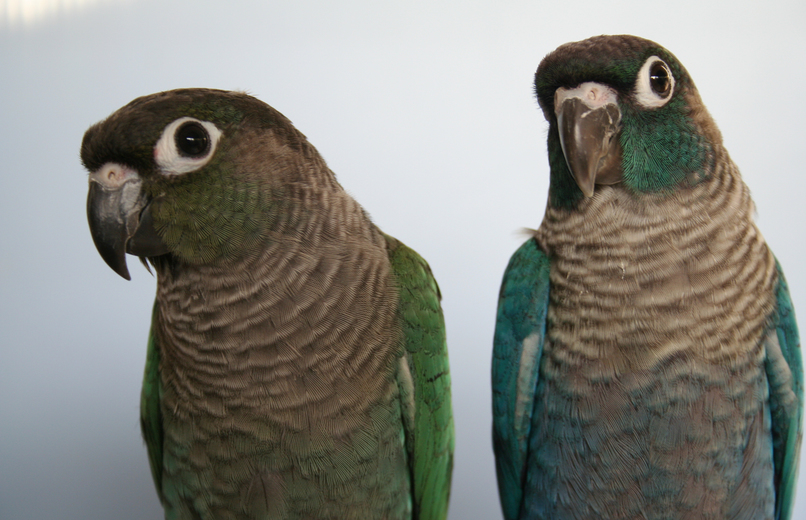The origin and breeding of the violet mutation

The first "dark" molinae
More than a decade ago – in 2002 – I discovered in a nest of normal (wildtype) Green-cheeked Conures a bird which was remarkably darker than the others. To confirm for myself, I called my wife to corroborate my findings. She immediately pulled out the darker green bird and described it as follows : “ The green of that one bird is much darker and bluer than the green of the others, which are much lighter and more yellow”. To clarify : the comparison was done between birds with the pure wild type colouring, NOT the Misty birds which are yellower and more golden.
With my previous experiences with Peach-faced Lovebirds and Lineolated parakeets, I first thought that this was an instance of Dark Factor, given the dark green colour much like the dark green Roseicollis or dark green Lineolated.
Difficult breeding
My breeding with these dark green Green-cheeked Conures (specie: Sordida) was one of trial and error, a lot of patience, and perseverance. Since the bird was possibly split turquoise, I paired it with a turquoise hen. The pair was compatible, and the birds were prepared for breeding, but when the hen was ready to mate, the dark green male killed her in the nest. Perhaps he did not like the turquoise hens because these events were repeated three times with turquoise hens, even when I gave the birds more space.
In this way I lost quite a lot of time. Finally I paired the bird with a normal wild type hen split for turquoise, and this (met) with success. However , a second problem now arose: the ‘dark green’ male produced a lot of infertile eggs and the eggs that did hatch gave weak chicks. But one thing I established for certain : the ‘dark green’ colour inherited further, proving it was a dominant mutation. Those who know me, know that I work slowly and thoughtfully, then hastily to strive for breeding in the short term. I therefore bred as many bloodlines as possible to create a great many unrelated birds, all with the purpose of pairing them with these dark green Green-cheeked Conures.
Not a dark factor, but a violet factor
To my great surprise, I noticed that I never bred olive, cobalt or mauve specimens. Therefore after some time I knew for sure that these were not dark factor birds as I had first thought. Through the study of various ‘dark’ chicks from the green and turquoise pairing, I could conclude that this was a violet factor.
The turquoise feathers of normal wild type Green-cheeked Conures are shaded by the violet to a deeper blue colour with a violet haze. The light yellow-green feather shade of the same colour wild birds are made a darker, more blue-green colour by the violet mutation (See photos).
Turquoise Green-cheeked Conures with the violet result in a deeper turquoise blue colour with a violet haze over it. (See photos).
I think the photographic material sufficiently clarifies my description above. I have shown these birds to some acquaintances over the past two years – mutation breeders and experts from different countries and continents – who came to visit me. Upon seeing and comparing the violet with the classic colours, they all confirmed my statement above.
Some remarks
On the one hand we might also speak of single and double factor violets, as I already have tree violets which are significantly darker in appearance. Those visitors who have (a) seen few of these birds confirm this theory.
On the other hand, my latest breeding results prove that the intensity of the violet in the Turquoise Green-cheeks can also be increased through selective breeding.
Currently I have already violets in the following mutations of the Greencheeked Conure (specie: Sordida) : violets in yellow-sided, in turquoise yellow-sided, and a few in turquoise cinnamon and in turquoise cinnamon yellow-sided.With the last mentioned mutations, the primary feathers are much lighter in the violet, and the violet colouring much more intense.
Regarding naming conventions, I deeply regret the use of the terms”blue”, “aqua” and “turquoise”. Currently, the term “turquoise” is most commonly used. In my opinion, my use of the term “violet in green” or “violet in turquoise” is more appropriate than the term “violet in blue”, especially as a pure blue Green-cheek does not exist yet.
Sometimes the larger and stronger Pyrrhura Molinae Molinae is bred in all other existing mutations, perhaps with the aim, among other things, for show specimens to obtain a larger size. Personally, I regret it, considering it is a different kind Green-cheek here that has a totally different morphology and colour intensity as the molinae sordida in which specie the violet is born. There exist for the moment only one real and rare mutation of the P.Molinae Molinae that resembles the yellow-sided mutation of the molinae sordida, but is larger, inherits differently, has dark black legs and has not the same colour intensity.
Some examples of the inheritance of the violet mutation
Green(Wild type) X Violet in Green
Offspring:
- 50% Green
- 50% Violet in Green
Turquoise X Violet in Turquoise
Offspring:
- 50% Turquoise
- 50% Violet in Turquoise
Green (Wild type) / Turquoise X Violet in Turquoise
Offspring:
- 25% Green / Turquoise
- 25% Turquoise
- 25% Violet in Green / Turquoise
- 25% Violet in Turquoise
Dear conure enthusiast : I hope that all that I have outlined here, gives more insight into this new mutation and I hope that the accompanying images clarify what I have written.
